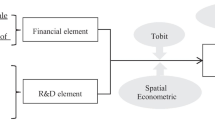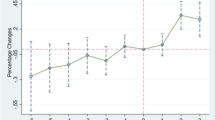Abstract
This paper uses the time cycle of nearly 20 years from 1999 to 2018, using the relevant panel data of 31 provinces and municipalities directly under the central government. Taking the establishment of Guangdong Free Trade Zone (FTZ) as a quasi-natural experiment to study the regional service innovation ability, the differences-in-differences method (DID) and the synthetic control method (SCM) were used to test the impact of the establishment of the FTZ on the regional service innovation ability. SCM compares the development track of non-FTZ and FTZ by constructing counterfactual analysis framework. As an auxiliary analysis method, DID also draws the conclusion that the FTZ policy has a positive role in promoting the development of regional service innovation ability, which has passed the robustness test. This paper expounds the operation basis of Guangdong Free Trade Zone, and puts forward policy suggestions for its future development. The results show that after the establishment of the FTZ, the average value of the regional service innovation capacity of Guangdong Province shows an obvious growth trend compared with the non-established provinces; the FTZ policy has a strong role in promoting regional service industry.




Similar content being viewed by others
Data Availability
The data can be accessed upon request.
References
Abadie, A., & Gardeazabal, J. (2003). The economic costs of conflict: A case study of the Basque Country. The American Economic Review, 93(1), 112–132.
Abadie, A., Diamond, A., & Hainmueller, J. (2010). Synthetic control methods for comparative case studies: Estimating the effect of California’ s tobacco control program. Journal of the American Statistical Association, 105(490), 493–505.
Aishah, T. N., Pyeman, J., & Tajuddin, R. M. (2021). Internal supply chain management (SCM) integration for long-term competitiveness. Modern Perspectives in Economics, Business and Management, 7, 1–7.
Aiwu, Z., Jingyi, W., & Hongjun, G. (2022). Has the free trade zone construction promoted the upgrading of the city’s industrial structure? Sustainability, 14(9), 5482.
Anning, A., & Roxan. (2008). What was Sure Start and why did it matter (pp. 3–15). Improving services for young children: From Sure Start to children’s centres.
Chen, L., Ye, W., Huo, C., & James, K. (2020). Environmental regulations, the industrial structure, and high-quality regional economic development: Evidence from China. Land, 9(12), 517.
Chen, X., & Yao, Z. (2004). Enhanced speed and precision of measurement in a computer-assisted digital cephalometric analysis system. The Angle Orthodontist, 74(4), 501–507.
Chiang, M. H. (2019). China–ASEAN economic relations after establishment of free trade area. The Pacific Review, 32(3), 267–290.
Cook, L. M., & Munnell, A. H. (2006). How does public infrastructure affect regional economic performance? New England Economic Review, 1990, 11–33.
Crochet, V., Hegde, V. (2020). China’s ‘Going global’ policy: Transnational production subsidies under the WTO SCM agreement. Journal of International Economic Law, 23(4), 841–863.
Dai, H., Wang, Y. (2008). Analysis on the relationship between industrial transfer and regional industrial structure adjustment. Contemporary Finance and Economics, 02, 93–98. (in Chinese).
Fouda, E. S. Y., Coulibaly, A. E., Keita, M., Pedro, A. (2021). Potentials of the African continental free trade area: A combined partial and general equilibrium modeling assessment for Central Africa. African Development Review, 33(3), 452–465.
Gao, Z., Li, X. (2019). Regional innovation development and its influence path under the background of the establishment of FTZ. Management Modernization, 39(05), 50–54. (in Chinese).
Haines, G. K. (1989). The Americanization of Brazil: A study of US Cold War diplomacy in the third world, 1945–1954. Wilmington: Sr Books.
Lee S. (2018). China’s service trade development and policy implications for Korea: Focused on major industrial and regional analysis. KIEP Research Paper, World Economy Brief, 18–27.
Li, N., & Qiao, Z. (2010). An empirical analysis of the effect of state-owned enterprise reform policy – Based on the estimation of double difference model. Research on Quantitative Economy, Technology and Economy, 27(02), 3–21. (in Chinese).
Li, S., Liu, J., & Kong, Y. (2021). Pilot free trade zones and Chinese port-listed companies performance: An empirical research based on quasi-natural experiment. Transport Policy, 111, 125–137.
Lin, J. Y. (2015). “One Belt and One Road” and free trade zones-China’s new opening-up initiatives 1. Frontiers of Economics in China, 10(4), 585.
Liu, Y., & Zhang, B. (2017). Evaluation of poverty alleviation effect of continuous development: An empirical study of Hebei province based on synthetic control method. Economic Forum, 07, 10–16. (in Chinese).
Liu, Z., Tang, T., & Yang, W. (2009). DEA evaluation of provincial fiscal expenditure efficiency. Economic Theory and Economic Management, 07, 50–56. (in Chinese).
Liu, J., Wang, X., & Guo, J. (2021). Port efficiency and its influencing factors in the context of pilot free trade zones. Transport Policy, 105, 67–79.
Lu, F., & Jin, D. (2011). The impact of China R & amp D input on economic growth: An empirical analysis based on panel data. China Industrial Economy, 03, 149–157. (in Chinese).
Montolio, M., Messeguer, J., Masip, I., Guijarro, P., & Gavin, R. (2009). A semaphorin 3A inhibitor blocks axonal chemorepulsion and enhances axon regeneration. Chemistry & Biology, 7, 691–701.
Qi, S., Cheng, S., & Cui, J. (2021). Environmental and economic effects of China’s carbon market pilots: Empirical evidence based on a DID model. Journal of Cleaner Production, 279, 123720.
Rameau R. (2020). The African perspective: The development of investment laws, the Pan-African Investment Code (PAIC), and the African Continental Free Trade Area in the “New Economic World Order”. Proceedings of the ASIL Annual Meeting. Cambridge University Press, 114: 62–67.
Rashnoodi, A., Soltani, M., Kordnaeij, A., & Hamidizadeh, A. (2019). Designing a meta frame work the competitiveness of free industrial-trade zones at the international levels employing the meta-synthesis approach. Journal of Marine Science and Technology, 18(3), 14–42.
Tang, Y. (2017). Research on traffic node setting in Northeast China under the background of “The Belt and Road Initiative.” Economic Forum, 07, 4–9. (in Chinese).
Tian, Q., Ma, J., & Gao, T. (2008). Analysis on regional differences of influencing factors of urban residents’ consumption in China. World Management, 07, 27–33. (in Chinese).
Venkataraman, S. (2004). Regional transformation through technological entrepreneurship. Journal of Business Venturing, 19(1), 153–167.
Wang, Y., & Zhang, J. (2014). The impact of the Olympic Games on air quality in Beijing: A study based on synthetic control method. China Population, Resources and Environment, 24(S2), 166–168. (in Chinese).
Wenlin, F., & Kunrong, S. (2006). The scale and structure of China’s public expenditure and its growth effect. Economic Science, 1, 20–29.
Widhiyanti, H. N. (2020). The urgency of harmonizing competition laws in moving towards the ASEAN free trade area. Fiat Justisia: Jurnal Ilmu Hukum, 14(1), 45–68.
Xiang, H., He, K., & Yu, Y. (2016). The establishment of FTZ in ShanghaiFinancial research, (10): 48–63. (in Chinese).
Yan, C., & Gong, L. (2009). Fiscal policy and economic growth under the framework of interaction between capital accumulation and innovation. World Economy, 32(01), 40–51. (in Chinese).
Yang, J., Wang, W., & Tan, N. (2016). To solve the puzzle of “institutional risk preference” in the location distribution of China’s foreign direct investment. World Economy, 39(11), 3–27. (in Chinese).
Ye, X. (2016). Location selection of FTZ (FTZ): An empirical study based on China’s provincial panel data. Contemporary Economic Science, 38(02), 115–123. (in Chinese).
Ye X, Tu S. (2019). Research on free trade zone and industrial structure upgrade--Empirical research based on Chinese provincial panel data. 2nd International Symposium on Social Science and Management Innovation (SSMI 2019). Atlantis Press, 315–318.
Yuan, W., Wu, Q., & Yan, H. (2008). Canonical correlation analysis of the relationship between fixed asset investment and economic growth in China. Modern Economy, S1, 107–117. (in Chinese).
Zhang, J. (2013). Research on the dynamic mechanism of investment in scientific and technological innovation and economic growth. Technical Economy and Management Research, 03, 35–39. (in Chinese).
Zhang, Y. (2014). Pilot FTZ and construction of open economic system. Academic Monthly, 46(01), 11–19. (in Chinese).
Zhang, J., Yan, D., Feng, Z., & Li, C. (2018). Can the establishment of FTZ effectively promote economic growth-Dynamic perspective research based on double difference method. Exploration of Economic Issues, 11, 125–133. (in Chinese).
Zhang, W., Ma, W., & Chen, Q. (2022). Does regional development policy promote industrial structure upgrading? Evidence from the Yangtze River Delta in China. Sustainability, 14(13), 8127.
Acknowledgements
The authors would like to thank those who contributed to this article, as well as the anonymous reviewers who provided valuable comments.
Author information
Authors and Affiliations
Contributions
Conceptualization: Yongqiang Lin. Research methods: Xueye Zhang. Data collection: Yongqiang Lin. Analysis: Yongqiang Lin. Investigation: Xueye Zha. Writing: Yongqiang Lin and Xueye Zhang.
Corresponding author
Ethics declarations
Ethical Approval
This article does not contain any studies with human participants or animals performed by any of the authors.
Informed Consent
The authors declare that all the authors have informed consent.
Conflict of Interest
The authors declare no conflict of interests.
Additional information
Publisher's Note
Springer Nature remains neutral with regard to jurisdictional claims in published maps and institutional affiliations.
This article is part of the Topical Collection on Innovation Management in Asia
Rights and permissions
Springer Nature or its licensor (e.g. a society or other partner) holds exclusive rights to this article under a publishing agreement with the author(s) or other rightsholder(s); author self-archiving of the accepted manuscript version of this article is solely governed by the terms of such publishing agreement and applicable law.
About this article
Cite this article
Lin, Y., Zhang, X. A Study on the Impact of Free Trade Zones on Regional Service Innovation Capability: Experimental Evidence from Guangdong Province Free Trade Zone. J Knowl Econ (2024). https://doi.org/10.1007/s13132-024-01936-7
Received:
Accepted:
Published:
DOI: https://doi.org/10.1007/s13132-024-01936-7




